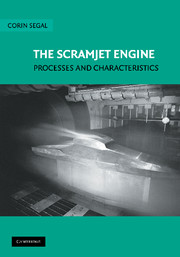Book contents
- Frontmatter
- Contents
- Preface
- List of Acronyms
- 1 Introduction
- 2 Theoretical Background
- 3 High-Temperature Gas Dynamics and Hypersonic Effects
- 4 Cycle Analyses and Energy Management
- 5 Inlets and Nozzles
- 6 Supersonic Combustion Processes
- 7 Testing Methods and Wind Tunnels
- 8 Computational Fluid Dynamic Methods and Solutions for High-Speed Reacting Flows
- Index
- References
1 - Introduction
Published online by Cambridge University Press: 19 January 2010
- Frontmatter
- Contents
- Preface
- List of Acronyms
- 1 Introduction
- 2 Theoretical Background
- 3 High-Temperature Gas Dynamics and Hypersonic Effects
- 4 Cycle Analyses and Energy Management
- 5 Inlets and Nozzles
- 6 Supersonic Combustion Processes
- 7 Testing Methods and Wind Tunnels
- 8 Computational Fluid Dynamic Methods and Solutions for High-Speed Reacting Flows
- Index
- References
Summary
The Ramjet and the Supersonic Combustion Ramjet (Scramjet) Engine Cycle
An invention attributed to René Lorin of France in 1913 (Hallion, 1995), the ramjet is a remarkable air-breathing engine in its conceptual simplicity. Lacking moving parts and achieving air compression only through internal geometry change, it is capable of extending the operation beyond flight speed when the gas-turbine engine becomes inefficient. The ramjet does not, however, operate from takeoff, and its performance is low at subsonic speeds because the air dynamic pressure is not sufficient to raise the cycle pressure to the efficient operational values.
Above a flight speed of around Mach 3, cycles using rotating machinery, i.e., compressors, are no longer needed to increase the pressure, which can now be achieved by changes in area within the inlet and the diffuser leading to the combustion chamber. Engines without core rotating machinery can operate with a higher maximum cycle temperature as the limit imposed by the turbine presence on the cycle maximum temperature can now be increased. The ramjet cycle with subsonic air speed at the combustion chamber entrance becomes more efficient. As the speed further increases, the terminal shock associated with subsonic combustion leads to both significant pressure losses and elevated temperatures that preclude, in great part, recombination-reaction completion, thereby resulting in considerable energy loss. It becomes more efficient to maintain the flow at supersonic speed throughout the engine and to add heat through combustion at supersonic speed.
Information
- Type
- Chapter
- Information
- The Scramjet EngineProcesses and Characteristics, pp. 1 - 15Publisher: Cambridge University PressPrint publication year: 2009
References
Accessibility standard: Unknown
Why this information is here
This section outlines the accessibility features of this content - including support for screen readers, full keyboard navigation and high-contrast display options. This may not be relevant for you.Accessibility Information
- 1
- Cited by
